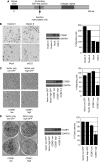Collagen and calcium-binding EGF domains 1 is frequently inactivated in ovarian cancer by aberrant promoter hypermethylation and modulates cell migration and survival
- PMID: 19935792
- PMCID: PMC2813742
- DOI: 10.1038/sj.bjc.6605429
Collagen and calcium-binding EGF domains 1 is frequently inactivated in ovarian cancer by aberrant promoter hypermethylation and modulates cell migration and survival
Abstract
Background: Collagen and calcium-binding EGF domains 1 (CCBE1) is an uncharacterised gene that has down-regulated expression in breast cancer. As CCBE1 maps to 18q21.32, a region frequently exhibiting loss of heterozygosity in ovarian cancer, the aim of this study was to determine the expression and function of CCBE1 in ovarian cancer.
Methods: Expression and methylation patterns of CCBE1 were determined in ovarian cancer cell lines and primary tumours. CCBE1 contains collagen repeats and an aspartic acid/asparagine hydroxylation/EGF-like domain, suggesting a function in extracellular matrix remodelling and migration, which was determined using small-interfering RNA (siRNA)-mediated knockdown and over-expression of CCBE1 in cell lines.
Results: CCBE1 is expressed in normal ovary, but is reduced in ovarian cancer cell lines and primary carcinomas. Pharmacological demethylation/deacetylation in ovarian cancer cell lines re-induced CCBE1 expression, indicating that epigenetic mechanisms contribute to its silencing in cancer. CCBE1 promoter hypermethylation was detected in 6/11 (55%) ovarian cancer cell lines and 38/81 (41%) ovarian carcinomas. siRNA-mediated knockdown of CCBE1 in ovarian cancer cell lines enhanced their migration; conversely, re-expression of CCBE1 reduced migration and survival. Hence, loss of CCBE1 expression may promote ovarian carcinogenesis by enhancing migration and cell survival.
Conclusions: These data suggest that CCBE1 is a new candidate tumour suppressor in ovarian cancer.
Figures




References
-
- Auersperg N, Wong AS, Choi KC, Kang SK, Leung PC (2001) Ovarian surface epithelium: biology, endocrinology, and pathology. Endocr Rev 22: 255–288 - PubMed
-
- Barnholtz-Sloan JS, Schwartz AG, Qureshi F, Jacques S, Malone J, Munkarah AR (2003) Ovarian cancer: changes in patterns at diagnosis and relative survival over the last three decades. Am J Obstet Gynecol 189: 1120–1127 - PubMed
-
- Barton CA, Hacker NF, Clark SJ, O’Brien PM (2008) DNA methylation changes in ovarian cancer: implications for early diagnosis, prognosis and treatment. Gynecol Oncol 109: 129–139 - PubMed
-
- Cantarini MC, de la Monte SM, Pang M, Tong M, D’Errico A, Trevisani F, Wands JR (2006) Aspartyl-asparagyl beta hydroxylase over-expression in human hepatoma is linked to activation of insulin-like growth factor and notch signaling mechanisms. Hepatology 44: 446–457 - PubMed
-
- Clark HF, Gurney AL, Abaya E, Baker K, Baldwin D, Brush J, Chen J, Chow B, Chui C, Crowley C, Currell B, Deuel B, Dowd P, Eaton D, Foster J, Grimaldi C, Gu Q, Hass PE, Heldens S, Huang A, Kim HS, Klimowski L, Jin Y, Johnson S, Lee J, Lewis L, Liao D, Mark M, Robbie E, Sanchez C, Schoenfeld J, Seshagiri S, Simmons L, Singh J, Smith V, Stinson J, Vagts A, Vandlen R, Watanabe C, Wieand D, Woods K, Xie MH, Yansura D, Yi S, Yu G, Yuan J, Zhang M, Zhang Z, Goddard A, Wood WI, Godowski P, Gray A (2003) The secreted protein discovery initiative (SPDI), a large-scale effort to identify novel human secreted and transmembrane proteins: a bioinformatics assessment. Genome Res 13: 2265–2270 - PMC - PubMed
Publication types
MeSH terms
Substances
LinkOut - more resources
Full Text Sources
Other Literature Sources
Medical
Research Materials

